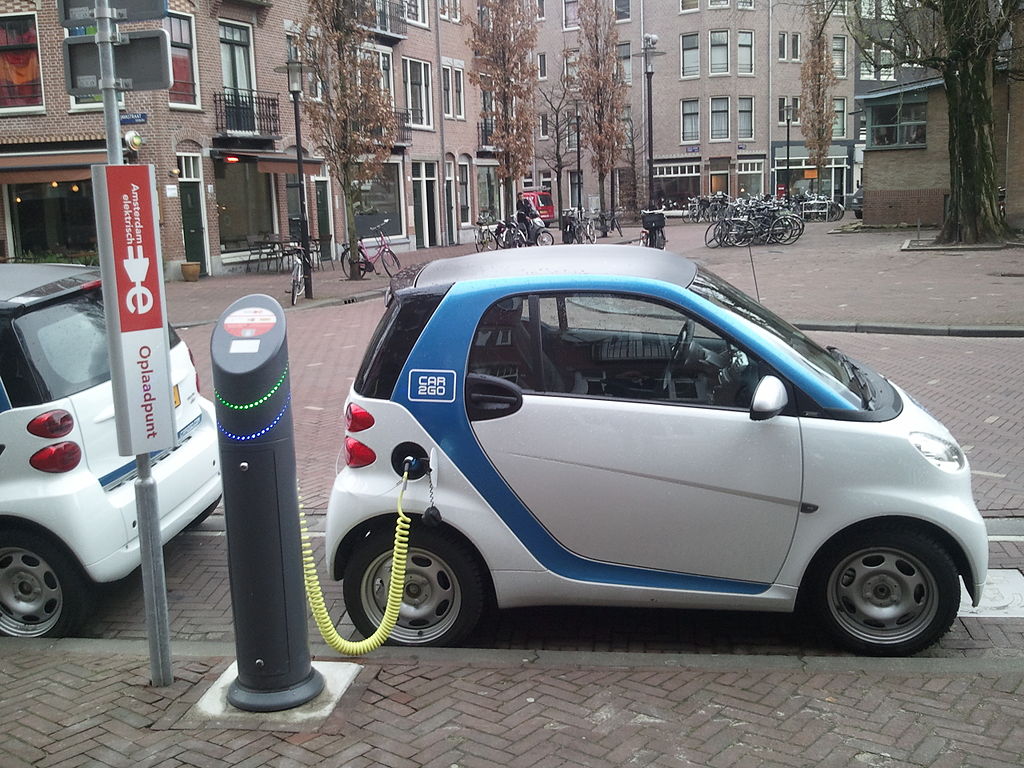
“Smart fortwo electric drive charging in Amsterdam”. Ludovic Hirlimann
By Mariana Meneses
Among the many current developments in transportation technologies, we explore three that may or may not reshape the landscape of transportation: Electric Vehicles (EVs), Hyperloop technology, and the reemergence of supersonic flight, shedding light on the possible future of how we move from point A to point B.
Electric vehicles: a mountain goat on wheels?

Image generated using ClipDrop.Co.
Electric vehicles (EVs) have revolutionized the automotive industry, offering a more sustainable and eco-friendly mode of transportation.
Although marketed as an eco-friendly solution, there remain many challenges with EVs. These include carbon emissions in their production, recycling of their components, and the significant amount of water used in the mining of scarce resources like lithium for their batteries. EV batteries significantly increase the weight of the vehicles, posing human safety issues in collisions and adding pollution from the increased quantity of rubber particles given off by their tires.
However, as governments continue to invest in technology and infrastructure, and implement regulations, ongoing scientific advancements hold the potential for breakthroughs.
As Brazilian science communicator Davi Calazans explains, in the absence of human-engineered infrastructure like roads, the complexities and limitations of wheels are significant challenges in natural environments. Evolution didn’t create wheels, but favors other forms of locomotion such as limbs, wings, and fins that are better suited to navigate diverse situations.
Despite the environmental benefits of electric vehicles (EVs), their cost-effectiveness continues to pose a significant hurdle for their widespread acceptance, given their higher initial cost compared to fossil fuel-burning vehicles. Furthermore, many locations provide very limited or no charging infrastructure, rendering it difficult for individuals lacking home charging facilities to depend on EVs as their primary means of transportation.
Aiming to inform policy makers and stakeholders about policy frameworks and market systems for electric vehicle adoption, a 2023 report from the International Energy Agency identifies and discusses recent developments in electric mobility across the globe. It examines key concerns such as electric vehicle and charging infrastructure deployment, battery demand, electricity consumption, oil displacement, greenhouse gas emissions, and related policy developments.
According to the Global EV Outlook 2023 projections, there are many potentially different scenarios we could face by 2030.
Under the Stated Policies and Announced Pledges scenarios, global electric vehicle (EV) sales could increase by around fourfold from 2022 to 2030. By 2030, EV sales are projected to reach over 70 million vehicles annually, representing approximately 60% of all vehicles sold. Under the Net Zero Emissions by 2050 Scenario, the number of EVs grows more rapidly, at an average annual rate of around 40%, reaching 380 million EVs on the roads in 2030.
The report shows that EV deployment leads to an increase in electricity consumption, implying a potential need to expand power generating capacity.
As they displace petroleum consumption, EVs may lead to revenue and employment losses in the oil and gas industry. The report also highlights implications for tax revenues, showing that governments may need to consider alternative forms of taxation in response to changing transportation systems. Finally, the report analyzes the consequences of EV deployment on greenhouse gas emissions, showing that while EVs themselves produce no direct emissions, there are significant emissions in their production, electricity use, and battery disposal which still need to be addressed to maximize environmental effectiveness.

Image generated using ClipDrop.Co.
The harms of climate change are becoming increasingly evident, with rising global temperatures, extreme weather events, melting ice caps, and sea-level rise taking center stage among many issues.
These changes not only threaten vulnerable ecosystems and wildlife but also have significant ramifications for human survival, including concerns about food security, water availability, and public health.
Climate change is deeply connected to the burning of fossil fuels, which releases greenhouse gases into the atmosphere and disrupts Earth’s natural heating and cooling cycles. Since vehicles powered by gasoline and diesel fuels account for 29% of annual greenhouse gas emissions, EVs play a pivotal role in curbing these climate-disrupting gases and fostering a cleaner and healthier environment. EVs also have the potential to be charged by renewable energy sources, such as wind and solar. Plus, as battery technology continues to evolve, electric vehicles can become more affordable, lightweight, and efficient with longer ranges between charges.
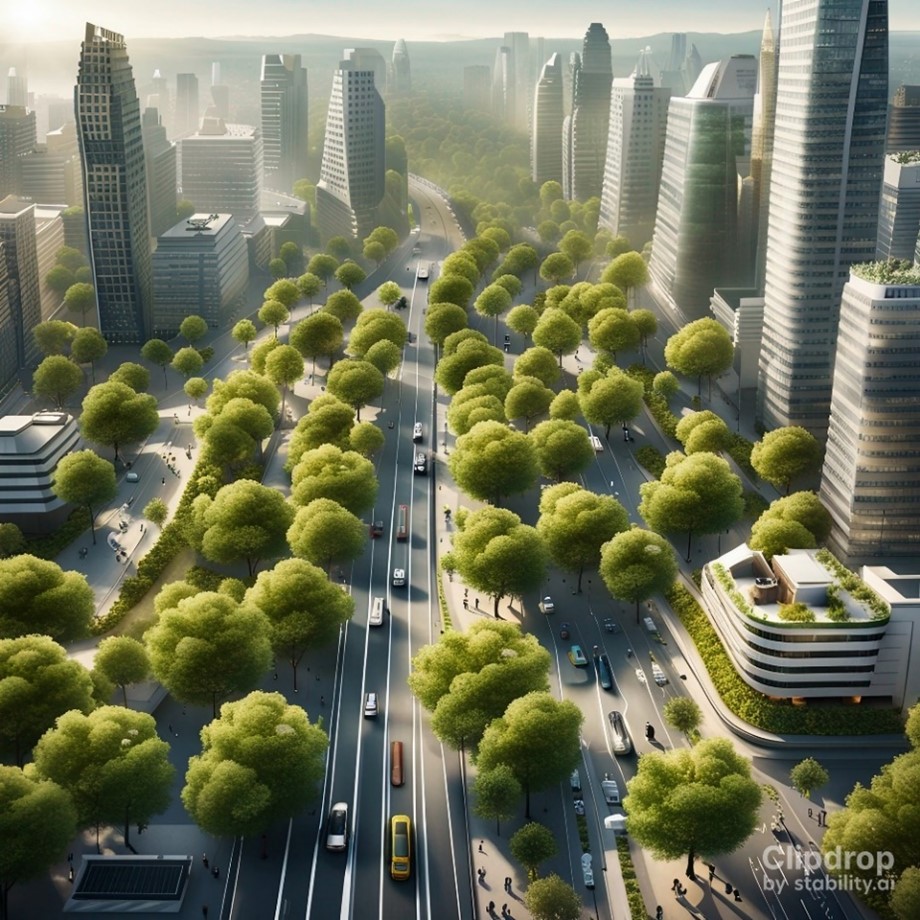
Image generated using ClipDrop.Co.
Governments worldwide acknowledge the significance of EVs in combating climate change, and many are introducing measures like tax credits and subsidies to promote their usage and affordability.
As reported by The New York Times, the U.S. government is actively pushing for the rapid adoption of electric cars in the fight against climate change. President Biden’s executive order aims for 50% of new car sales to be all-electric by 2030, while the US Environmental Protection Agency (EPA) is proposing regulations to curtail tailpipe pollution from gasoline-powered vehicles.
Nevertheless, it is crucial to ensure a swift transition to EVs and other fossil fuel-free transportation technologies that align with climate targets while remaining affordable and accessible to consumers.
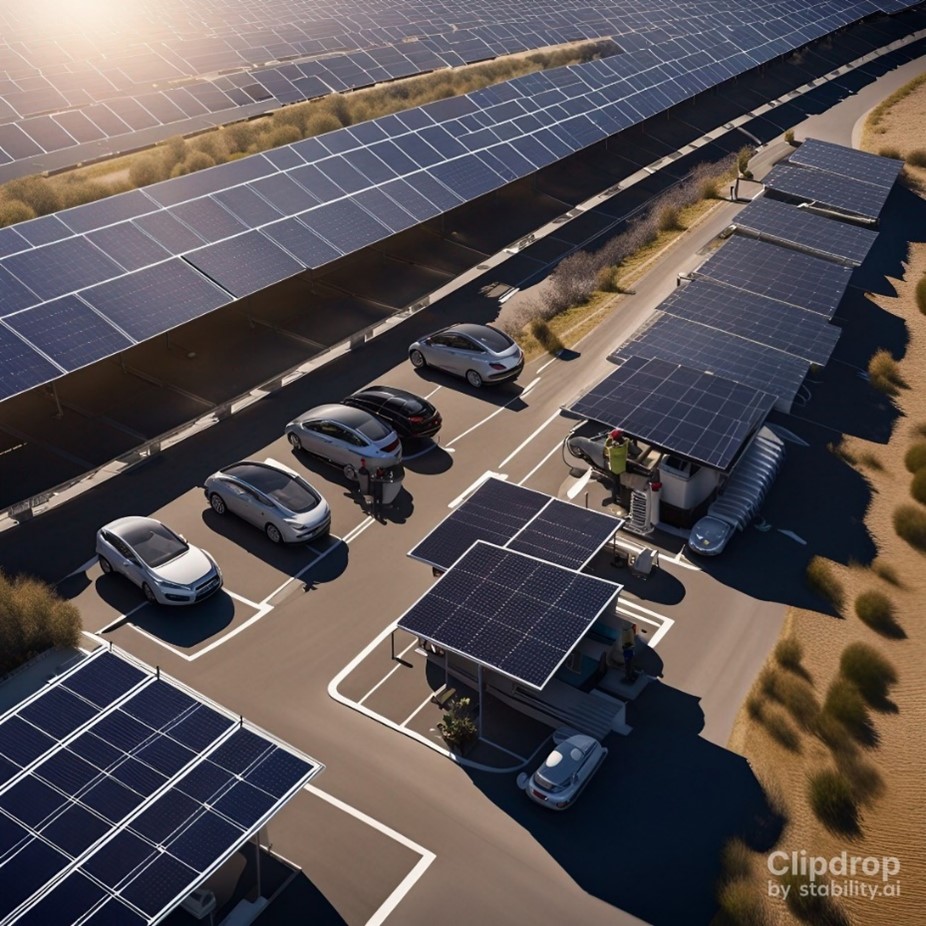
Image generated using ClipDrop.Co.
It is worth noting that advancements in battery technology are vital for the growth of EVs.
As batteries become more powerful and efficient, electric cars can offer longer driving ranges and faster charging times, making them more practical for consumers. Improvements in battery technology will also have environmental benefits. Recycling and repurposing used EV batteries can reduce waste and the need for new materials, and sustainable manufacturing processes can minimize the carbon footprint of electric vehicles.
Thus, research and innovation in battery technology are crucial to improve performance, reduce environmental damage, and expedite the transition to a low-carbon transportation system.

Image by Darklich14
Hyperloop: there are still believers

Elon Musk’s Hyperloop passenger transport capsule conceptual design sketch, 2013. Tesla’s Hyperloop Alpha paper
Announced as the future of high-speed transportation, hyperloop technology could still, perhaps, be only a few years away from reality. In theory, this technology could allow us to travel more safely, less expensively, and faster than we do today.
But there have been – and still seem to be – many obstacles before we get there.
The idea to use tubes for transportation is not new. For a long time, written messages and physical items were exchanged through the pneumatic tube system (also known as capsule pipelines). The idea of putting trains inside vacuum tubes is also not new. The first mention of a ‘vactrain’ dates to 1904, when it was proposed by engineer and physicist Robert Goddard, and since the 1970s there has been a plan to build a network of high-speed trains inside near-vacuum tunnels in Switzerland.
So, why isn’t the hyperloop a reality yet?
“These are systems that propel cylindrical containers through networks of tubes by compressed air or by partial vacuum. In the late 19th and early 20th centuries, pneumatic tube networks gained acceptance in offices that needed to transport small, urgent packages, such as mail, other paperwork, or money, over relatively short distances, within a building or, at most, within a city” (Wikipedia).
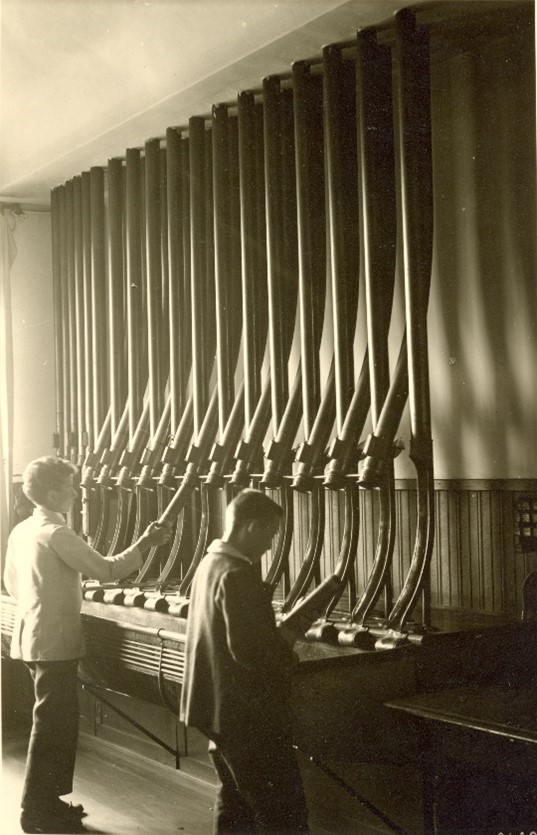
A pneumatic tube system – Mail services were once dependent on tubes. BASF
In 2013, Elon Musk published the Hyperloop Alpha, an open source document with a detailed outline for the Hyperloop technology.
But he also needed a prototype and so, from 2015 to 2019, his company SpaceX sponsored competitions in which teams presented prototypes for testing. The winning design, from the Technical University of Munich, became the basis for future versions of the technology.
Once completed, the passenger capsules inside the sealed tubes are supposed to travel faster than a bullet train, and even faster than a commercial jet aircraft. You could ask: why don’t we just build faster planes? The problem can be summarized in two words: air resistance. For a plane to travel at supersonic speeds, impractical quantities of fuel would be required, as explains physicist Dr. Sabine Hossenfelder.
“At such high speed, air resistance rises rapidly. Even if you manage to prevent the plane from melting or simply falling into pieces, you still need a lot of fuel to counter the pressure of the atmosphere. You could instead try flying so high up that the atmosphere is incredibly thin. But you have to get there in the first place, and that too consumes a lot of fuel.”
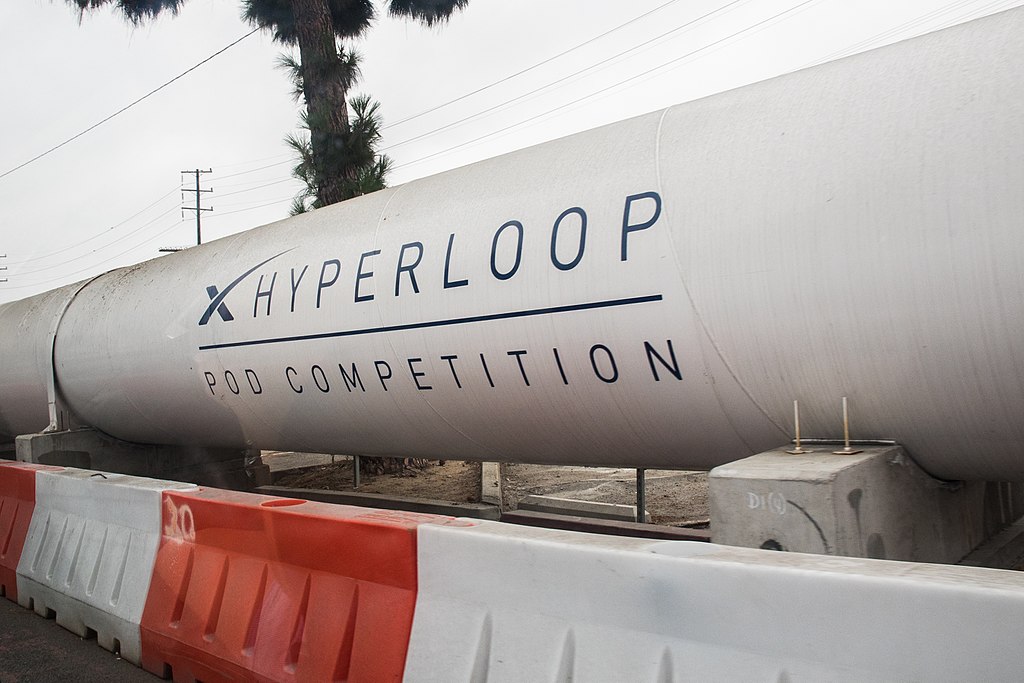
Hyperloop competition pod, 2017. Okras
The Hyperloop consists of magnetic capsules, or pods, levitating inside a tube and traveling at supersonic speeds.
That’s why it needs airtight tubes, in a near-vacuum state so there is no air drag and the capsules can reach the intended high velocities.

Virgin Hyperloop One XP-1 test pod on display at Rockefeller Center, 2019. Wikimedia Commons
Musk’s 2013 proposal, which initially featured air-cushions, has seen improvements like magnetic levitation (maglev) to reduce friction between pods and the tube-shaped track.
However, maglev introduces challenges like the need for costly cryogenic systems to reduce operating temperatures, and maintaining a vacuum over long distances.
In Musk’s 2013 plan, each capsule would be able to transport 28 or more passengers, and the system would have an hourly capacity of 30,000 passengers. A trip from Los Angeles to San Francisco, requiring 600 kilometers by road, would be completed in 45 minutes for a cost of less than one hundred dollars per passenger.
According to Sara McBride, for Bloomberg, as of 2023, the Hyperloop concept is still being pursued, but it has faced significant challenges.
Despite the vision of transporting passengers between cities at nearly the speed of sound, no startup has succeeded in creating a fully functional Hyperloop system after ten years and hundreds of millions of dollars invested. Some companies, like the Richard Branson-backed startup Hyperloop One, have pivoted to moving freight. Hyperloop Transportation Technologies Inc., one of the longest-standing leaders in the arena, even abandoned an attempt to go public. These challenges raise questions about the real-world viability of the Hyperloop system. However, there are still proponents who believe in the technology and continue to work on it.
Supersonic flight

“The Commanding Officer of the “Black Knights” of Marine Fighter Attack Squadron Three One Four (VMFA-314) performs a supersonic fly-by for Columbia’s visual effects unit, while filming for the motion picture production “Stealth” on board USS Carl Vinson (CVN 70).” PHAN Chris M. Valdez
As of 2023, supersonic flight is still a significant area of interest in the aviation industry even after the cancellation of costly Concorde service operated by British Airways and Air France from 1976-2003.
Several companies are developing supersonic aircraft with the aim of reducing travel times significantly. For instance, according to BBC, in 2021, United Airlines announced plans to buy 15 new supersonic airliners and return supersonic speeds to aviation by 2029. Similarly, as reported by the World Economic Forum, American Airlines has committed to buy up to 20 Overture jets developed by Boom Supersonic. However, there are challenges to overcome, including noise pollution, fuel consumption, and the need for sustainable aviation fuels.
Despite these challenges, the development of supersonic flight is seen as a promising advancement in aviation.
According to the World Economic Forum, new aircraft technologies, such as Boom’s Overture, are being designed with a focus on environmental sustainability.
Their developers aim to achieve carbon neutrality, striving for a net zero carbon footprint by balancing the amount of carbon emissions the aircraft produce with the amount they offset or eliminate. One of the ways they plan to do this is by using sustainable aviation fuels. These are fuels produced from sustainable resources like biomass that can significantly reduce aviation’s carbon footprint compared to conventional jet fuel. However, a major challenge lies in scaling up the production of these sustainable fuels which currently make up a small fraction of the fuel used in air travel.
Increasing their production is crucial for reducing the overall carbon emissions of the aviation industry and making air travel more environmentally friendly.
Conclusion
The adoption of sustainable transportation solutions is a fraction of the multifaceted endeavor required to combat the formidable challenge of today’s climate crisis.
To establish a truly sustainable system, our primary focus should center on prioritizing the transition to renewable energy sources. This entails channeling investments into the development of infrastructure for renewable energy generation and storage, concurrently advocating for energy efficiency and conservation strategies. By joining forces on multiple fronts, we can chart a path towards a genuinely sustainable system that not only addresses the perils of climate change but also nurtures a healthier planet for future generations.
Interested in exploring related topics? Discover these recommended TQR articles:
- Saving the Planet: Nobel Prize Recognizes Climate Science, but Will Mindsets Change in Time to Sustain Nature’s Potential and Value?
- Searching For Martian Life with X-Ray Crystallography
- Technology Fuels Advances in Citizen Science
- Beyond the Binary: Can Machines Achieve Conscious Understanding?
- Minding the Future: The State of Global AI Regulations



